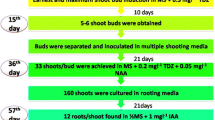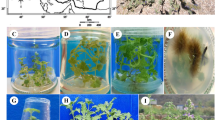Abstract
Eulophia dabia (D. Don) Hochr is an endemic, critically endangered, terrestrial orchid species having profound importance in traditional herbal drug preparations and pharmacopoeia worldwide. In the present investigation, we have developed an efficient and genetically stable micropropagation protocol of E. dabia using axenic rhizome as explant. Seeds inoculated on half-strength Murashige and Skoog (MS) medium showed 5% germination efficiency. Scanning electron microscopy analysis revealed differential effects of various sterilizing agents (NaOCl2 and ethanol) on the seed coat integrity leading to a significant improvement in seed germination rate. The rhizome-like bodies (RLBs) developed after 6 mo of seed germination showed best growth of rhizome (size: 3.3 × 1.5 cm and 5.0 nodes per rhizome) in MS medium containing casein hydrolysate and activated charcoal. One-year-old mature axenic rhizomes were further sub-cultured for multiple shoot induction, and maximum 96.1% response was observed in MS medium fortified with 4.4 μM BAP and activated charcoal with 4.3 mean shoot number and 13.4 cm shoot length. After 3 to 4 sub-cultures using the same medium, bipolar structures (plantlets with shoot and root) were developed. The properly developed plantlets were successfully acclimatized to open environment with 98% survival. Genetic stability of the discussed protocol was evaluated by random amplified polymorphic DNA (RAPD) markers, which proved true to typesets of the in vitro raised plants. In the present study we optimized in vitro propagation system for the E. dabia which can be successfully applied further for the genetic improvement studies and commercial scale propagation.






Similar content being viewed by others
References
Auvira FD, Mercuriani IS, Aloysius S (2021) Genetic variability analysis of terrestrial Spathoglottis plicata orchid variants based on RAPD marker. In: Proceedings of the 7th International conference on research, implementation, and education of mathematics and sciences (ICRIEMS 2020). Atlantis Press, pp 70–75
Baskin CC, Baskin JM (2014) Seeds: ecology, biogeography, and evolution of dormancy and germination. 2nd ed. CA: Elsevier Academic Press, San Diego
Bhattacharyya P, Kumaria S, Diengdoh R, Tandon P (2014) Genetic stability and phytochemical analysis of the in vitro regenerated plants of Dendrobium nobile Lindl., an endangered medicinal orchid. Meta Gene 2:489–504. https://doi.org/10.1016/j.mgene.2014.06.003
Bhattacharyya P, Van Staden J (2018) Molecular insights into genetic diversity and population dynamics of five medicinal Eulophia species: a threatened orchid taxa of Africa. Physiol Mol Biol Plants 24:631–641
Chang C, Hu W, Chen Y, Su Y, Chiu YT (2010) In vitro flowering and mating system of Eulophia graminea Lindl. Bot Stud 51:357–362
Chauhan NS (1990) Medicinal orchids of Himachal Pradesh. J Orchid Soc India 4:99–105
Chauhan S, Pathak P, Anuprabha SS (2015) Regeneration of Eulophia dabia through rhizome explants and flowering: a study in vitro. J Orchid Soc India 29:61–65
Davoudpour Y, Schmidt M, Calabrese F, Richnow HH, Musat N (2020) High resolution microscopy to evaluate the efficiency of surface sterilization of Zea mays seeds. PloS One 15:e0242247
Decruse SW, Reny N, Shylajakumari S, Krishnan PN (2013) In vitro propagation and field establishment of Eulophia cullenii (Wight) Bl., a critically endangered orchid of Western Ghats, India through culture of seeds and axenic seedling-derived rhizomes. In Vitro Cell Dev Biol - Plant 49:520–528
Deepak P, Kheta R, Harish SNS (2012) In vitro propagation of Eulophia nuda Lindl., an endangered orchid. Sci Hortic 139:46–52
Doyle JJ, Doyle JL (1987) A rapid DNA isolation procedure from small quantities of fresh leaf tissue. Phytochem Bull 19:11–15
Fu YY, Jiang N, Wu KL, Zhang JX, Teixeira da Silva JA, Duan J, Liu HT, Zeng SJ (2016) Stimulatory effects of sodium hypochlorite and ultrasonic treatments on tetrazolium staining and seed germination in vitro of Paphiopedilum SCBG Red Jewel. Seed Sci Technol 44:77–90. https://doi.org/10.15258/sst.2016.44.1.13
Hossain MM (2008) Asymbiotic seed germination and in vitro seedling development of Epidendrum ibaguense Kunth. (Orchidaceae). Afr J Biotechnol 7:3614–3619
Hossain MM, Sharma M, Pathak P (2009) Cost effective protocol for in vitro mass propagation of Cymbidium aloifolium (L.) Sw.- a medicinally important orchid. Eng in Life Sci 9:444–453
Hossain MM, Sharma M, Pathak P (2013) In vitro propagation of Dendrobium aphyllum (Orchidaceae)-seed germination to flowering. J Plant Biochem Biotechnol 22:157–167
Hossain MM, Sharma M, da Silva JAT, Pathak P (2010) Seed germination and tissue culture of Cymbidium giganteum Wall. ex Lindl. Sci Hortic 123:479–487
Jamir C, Devi J, Deka PC (2002) In vitro propagation of Cymbidium iridiodes and C. lowianum. J Orchid Soc India 16:83–89
Jalal JS, Jayanthi J (2015) An annotated checklist of the orchids of Western Himalaya, India. Lankesteriana 15:7–50
Jalal JS, Kumar P, Rawat GS, Pangtey YPS (2008) Orchidaceae, Uttarakhand, Western Himalaya, India. Check List 4:304–320
Johnson TR, Stewart SL, Dutra D, Kane ME, Richardson L (2007) Asymbiotic and symbiotic seed germination of Eulophia alta (Orchidaceae)-preliminary evidence for the symbiotic culture advantage. Plant Cell Tiss Org Cult 90:313–323
Joshi R, Shukla A, Kumar P (2013) In vitro water deficit stress induced genotypic alterations in protein profile among aromatic rice varieties. Ann Plant Sci 2:455–458
Joshi R, Shukla A, Sairam RK (2011) In vitro screening of rice genotypes for drought tolerance using polyethylene glycol. Acta Physiol Plant 33:2209–2217
Kauth PJ, Vendrame WA, Kane ME (2006) In vitro seed culture and seedlings development of Calopogon tuberosus. Plant Cell Tiss Org Cult 85:91–102
Knudson L (1946) A new nutrient solution for germination of orchid seed. Am Orchid Soc Bull 15:214–217
Lee Y-I (2011) In vitro culture and germination of terrestrial Asian orchid seeds. Methods Mol Biol 710:53–62
Lukens LN, Zhan S (2007) The plant genome’s methylation status and response to stress: implications for plant improvement. Curr Opin Plant Biol 10:317–322
Malmgren S (1996) Orchid propagation: theory and practice. In: Allen C (Ed.), Proceedings of the North American Native Terrestrial Orchids: Propagation and Production. North American Native Terrestrial Orchid Conference, Maryland, pp 63–71
McAlister BG, Van Staden J (1998) In vitro culture of Eulophia species. S Afr J Bot 64:264–266
Medina RD, Flachsland EA, Gonzalez AM, Terada G, Faloci MM, Mroginski LA (2009) In vitro tuberization and plant regeneration from multi nodal segment culture of Habenaria bractescens Lindl., an Argentinean wetland orchid. Plant Cell Tiss Org Cult 97:91–101
Mishra MK, Pandey S, Misra P, Niranjan A (2020) In vitro propagation, genetic stability and alkaloids analysis of acclimatized plantlets of Thalictrum foliolosum. Plant Cell Tiss Org Cult 142:441–446
Mitra GC, Prasad RN, Roychowdhury A (1976) Inorganic salts and differentiation of protocorms in seed callus of orchid and correlative changes in its free amino acid content. Indian J Exp Biol 14:350–351
Murashige T, Skoog F (1962) A revised medium for rapid growth and bioassays with tobacco tissue cultures. Physiol Plant 15:473–497
Nanekar V, Shriram V, Kumar V, Kishor PBK (2014) Asymbiotic in vitro seed germination and seedling development of Eulophia nuda Lindl., an endangered medicinal orchid. Proc Natl Acad Sci India Sect B Biol Sci 84:837–846
Novikova TI, Asbaganov SV, Ambros EV, Zaytseva YG (2020) TDZ-induced axillary shoot proliferation of Rhododendron mucronulatum Turcz and assessment of clonal fidelity using DNA-based markers and flow cytometry. In Vitro Cell Dev Biol - Plant 56:307–317
Oliya BK, Chand K, Thakuri LS, Baniya MK, Sah AK, Pant B (2021) Assessment of genetic stability of micropropagated plants of Rhynchostylis retusa (L.) using RAPD markers. Sci Hort 281:110008
Pandey S, Patel P, Prasad A, Sawant SV, Misra P (2020) Assessment of direct shoot organogenesis and genetic fidelity in Solanum viarum Dunal-a commercially important medicinal plant. In Vitro Cell Dev Biol - Plant 56:538–547
Pathak P, Bhattacharya A, Vij SP, Mahant KC, Dhillon MK, Piri H (2010) An update on the medicinal orchids of Himachal Pradesh with brief notes on their habit, distribution, and flowering period. J Non-Timber Forest Prod 17:365–372
Phillips RL, Kaeppler SM, Olhoft P (1994) Genetic instability of plant tissue cultures: breakdown of normal controls. Proc Natl Acad Sci 91:5222–5226
Rahman M, Rajora O (2001) Microsatellite DNA somaclonal variation in micropropagated trembling aspen (Populus tremuloides). Plant Cell Rep 20:531–536
Rani V, Raina SN (2000) Genetic fidelity of organized meristem derived micropropagated plants: a critical reappraisal. In Vitro Cell Dev Biol - Plant 36:319–330
Samarfard S, Kadir MA, Kadzimin SB, Ravanfar S (2013) Genetic stability of in vitro multiplied Phalaenopsis gigantea protocorm-like bodies as affected by chitosan. Not Bot Horti Agrobot Napoca 41:177–183
Sarkar J, Banerjee N (2020) Influence of different cytokinins on micropropagation of an important medicinal plant, Solanum erianthum D. Don, and assessment of the genetic fidelity of the regenerants. In Vitro Cell Dev Biol - Plant 56:480–490
Shekhar N, Promila P, Sharma K (2008) Some commercially significant Indian orchids. In: Vij et al. (Eds) Proc. Natl. conference on orchids: science and society. The Orchid Society of India, Chandigarh, India, pp 4-15
Srinivasan P, Raja HD, Tamilvanan R (2021) Efficient in vitro plant regeneration from leaf-derived callus and genetic fidelity assessment of an endemic medicinal plant Ranunculus wallichianus Wight & Arnn by using RAPD and ISSR markers. Plant Cell Tiss Org Cult. https://doi.org/10.21203/rs.3.rs-432950/v1
Tikendra L, Amom T, Nongdam P (2019) Molecular genetic homogeneity assessment of micropropagated Dendrobium moschatum Sw.-a rare medicinal orchid, using RAPD and ISSR markers. Plant Gene 19:100196
Tikendra L, Potshangbam AM, Dey A, Devi TR, Sahoo MR, Nongdam P (2021) RAPD, ISSR, and SCoT markers based genetic stability assessment of micropropagated Dendrobium fimbriatum Lindl. var. oculatum Hk. f.-an important endangered orchid. Physiol Mol Biol Plant 27:341–357
Vij SP, Verma J (2005) Eulophia dabia (D. Don) Hochr.: a new orchid record for Haryana State, India. J Orchid Soc India 19:47-49
Vujanovic V, St-Arnaud M, Barabe D, Thibeault G (2000) Viability testing of orchid seed and the promotion of colouration and germination. Ann Bot 86:79–86
Wang XJ, Hsiao KC (1995) Sugar degradation during autoclaving: effects of duration and solution volume on breakdown of glucose. Physiol Plant 94:415–418
Xu Y, Zhang J, Shao J, Feng H, Zhang R, Shen Q (2020) Extracellular proteins of Trichoderma guizhouense elicit an immune response in maize (Zea mays) plants. Plant Soil 449:133–149
Yadav K, Aggarwal A, Singh N (2013) Evaluation of genetic fidelity among micropropagated plants of Gloriosa superba L. using DNA-based markers-a potential medicinal plant. Fitoterapia 89:265–270
Acknowledgements
The authors are thankful to the Director, Botanical Survey of India, and Head of Office, Botanical Survey of India, Dehradun, for the necessary facility and encouragement.
Author information
Authors and Affiliations
Corresponding author
Ethics declarations
Competing interests
The authors declare no competing interests.
Rights and permissions
About this article
Cite this article
Panwar, G.S., Joshi, B. & Joshi, R. Axenic rhizome culture and genetic fidelity assessment of Eulophia dabia (D. Don) Hochr: an endangered terrestrial orchid species. In Vitro Cell.Dev.Biol.-Plant 58, 567–576 (2022). https://doi.org/10.1007/s11627-022-10258-9
Received:
Accepted:
Published:
Issue Date:
DOI: https://doi.org/10.1007/s11627-022-10258-9




